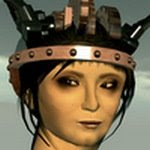Posted by Alpha Auer
"The Spine Jetpack". The mechanical neko ears and tail, the steampunk clock bracelets and the boots are designed by Thomus Keen as well.
I cannot possibly have one favorite designer in Second Life®. Indeed I cannot have 10, or 50 or even a hundred - there are that many talented, imaginative people out there, all of whose output never ceases to delight me - not to mention of course, totally bankrupt me ;-)... However, if someone were to push me up against a prim wall and hold a virtual gun to my head - under such dire circumstances of duress, I might conceivably divulge the name of Thomus Keen as being on the very very top of my list.

"The Steampunk Glider"
Being the builder of Steam Forge and Steam Isle, one of which also houses his design enterprise Steam Powered Nuts; as well as the quite recently rezed Role Play environment called Apocolyptica (intentionally mis-spelt ;-), Thomus Keen's prowess as a virtual architect will definitely need to get covered in a separate future post. Today I will focus on objects and vehicles designed by Keen. I have not been able to interview Thomus Keen at such a length as I would have liked to have done, however looking at his Renderosity homepage I am inclined to think that the artist T.King, who is Thomus Keen's Real Life manifestation, is a professional game environment designer who has worked on the likes of Everquest, World of Warcraft, and Vanguard: Saga of Heroes.

"The Airship Davintus"
In the one brief conversation that he and I had some time ago, I did manage to gain some insight into the working processes behind his fine output when Keen told me that he "fuss(es) a lot over details and quality, so sometimes it can take a month or more for a single release", after which point he changes very little of the original design, adding that like all Second Life designers worth their mettle he too has his ongoing battle with prim counts, particularly in attached objects, with regards to avatar render cost. Thus a very long time is also spent in prim reduction processes; a good example to which would be a Katana which started out at 130 prims, and when it was finally done, was down to 49 prims, thanks to numerous custom made sculpties. 

"The Gearwing Raptor"
In Second Life, Keen describes his area of design expertise as "Industrialized Steampunk". Now, the gentle reader of this blog will probably have surmised by now that my personal preferences definitely lean towards the man made. Not to put too fine a point on it, I am not really much of a "nature girl" at all. Hardly surprising then that the mechanical, the industrial interests me and holds my imagination. And Second Life certainly proliferates in the type of output that captures me, over and over again. Even so, Thomus Keen's design work I find particularly fascinating: These absolutely Impossible in Real Life gadgets, flight equipment, jet packs and gigantic airborne vessels seem to me to hold a mechanical precision that is such that were they to be constructed in Real Life there would be no question that they would be fully operational. Structures like the Airship Davintus or the Gearwing Raptor, are such that every nut and bold, every joint, seems to adhere to an impeccable design logic which culminates in a Gestalt utterly convincing in its functionality. Keen also manages to convey this functionality in his textures which to me are probably the most convincing ones that I have ever seen in Second Life. Thus, the webs that join the mechanic/metallic poles of the flight attachment called the Steampunk Glider are textured in such a way that that we visually sense that these webs are of a far lighter material - possibly canvas or maybe even some kind of light durable parchment - than the dark poles and central flight mechanism that tie the whole thing into one cohesive structure - one fully capable of flying, one which conveys the very logic of being airborne.
"The Stephenson Rocket", 1829. Collection of the National Museum of Science and Industry in London.
"The Apollo 10 Space Capsule", 1969. Collection of the National Museum of Science and Industry in London.
However, it is not only the precision of the design but also the way in which Keen's work seems to reside upon very firm historic design references, which for me, ultimately sets him in a class apart. This strikes me to be very much the case throughout Keen's output, but becomes especially apparent in the way in which he endows wooden objects with mechanical usage, as was indeed very much the practice during the early days of the Industrial Revolution. Although not too overly fond of museums as a rule, I do make an exception when it comes to Science Museums, and particularly the one in London, where I have most probably spent entire weeks pondering upon the mechanical object throughout its history, but particularly during the 19th century, the age of the Industrial Revolution. But not only that period either: Gazing at the Apollo 10 Space Capsule in close proximity to Stephenson's Rocket one becomes aware of the unique aesthetics residing within the functionality of the mechanical object and how this provides a continuity of a visual language of design from spacecraft and early day steam engines to astrolabes, cannons and armillary spheres. It is this aesthetics of functionality that Thomus Keen seems to be tapping into and which he displays in his many gadgets and vehicles at Steam Powered Nuts, where incidentally you can also find wonderful industrial jewelry, mechanical neko attachments and various other avatar apparel such as boots and weapons, all crafted by the extraordinary Thomus Keen.
It should be added here that Steam Powered Nuts also carries a wonderful fashion line specialized in Victorian Steampunk and Badlands apparel, designed by Thomus Keen's talented business associate Destany Laval, who in all likelihood will provide material for a future blog post before too long.
You can teleport to Steam Powered Nuts directly from here. You can also see larger, more detailed images of Keen's flight objects and vehicles here.
Friday, November 21, 2008
Industrial Steampunk =Thomus Keen
Posted by
Alpha Auer
at
8:00 AM
![]()
Labels: Destany Laval, Fairchang Isle, Industrial, NPIRL, Second Life®, SL, Steam Powered Nuts, steampunk, textures, Thomus Keen








1 comments:
Great post!
Post a Comment